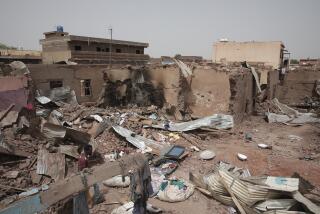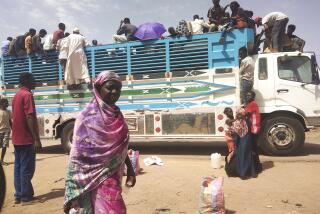In Sudan, a 12-Year-Old Girl Can Be Bought for $50
- Share via
It is a year before the millennium and Theresa Nybol Deng is a slave. In May, she was taken captive when the government-armed militia stormed her village in southern Sudan. Soldiers shot the men, looted the village and carted off as many women and children as they could. Theresa is 12 years old. She can be purchased for $50.
If her fate is anything like that of tens of thousands of black Africans who have become chattel in Sudan’s civil war, Theresa has been sold and bought. She is likely serving a master somewhere in northern Sudan, Libya or the Persian Gulf. If she was selected as a concubine, she will have been genitally mutilated--to be acceptable in her master’s culture--and then she will have been bred.
Theresa is a victim of a religious war, which also is this century’s longest lasting armed conflict. For more than a decade, the Islamic fundamentalist government in Sudan has been using slave raids as the terror weapon of choice in its self-declared “holy war” on the African population in the south. While the goal is to Islamize and Arabize Sudan’s Christians and tribalists, the Islamist extremists in Khartoum also have devastated the moderate Muslim Nuba peoples. Slaves like Theresa are given Arab names and forcibly converted to Islam.
Slavery in Sudan has been well researched. Among the first to report slave raids was a courageous Arab professor from the University of Khartoum. He was jailed for his effort. Since then, journalists, human rights organizations and the U.N. have documented these raids. U.N. special investigator Gaspar Biro visited Sudan several times and confirmed that human bondage was a tactic of this war. Reporting on “modern day slave markets,” Biro found that “the racial dimension of the violations and abuses against children constitutes a particularly grave and alarming circumstance, which should be of particular concern from a human rights perspective.”
Yet the fate of Theresa and her people has not been of particular concern in the West. Because of scant media coverage or because many people don’t know or because this slavery doesn’t fit the familiar black and white pattern or because we fear offending the Muslim world, a shameful silence pervades.
Thankfully, that is beginning to change. America, after all, is a nation that tore itself apart over the issue of one person owning another, and Americans who learn of today’s black slavery do not remain silent. Barbara Vogel, a fifth grade teacher from Denver, has sparked a national movement. After she read a news article on slavery to her class, the kids saved their lunch money to purchase the freedom of Sudanese slaves. They joined an international rescue effort that so far has emancipated and returned more than 4,000 people to their villages. Dozens of classes from across the country have joined the campaign. Who says our public schools are failing?Redeeming individual slaves for cash saves lives and garners attention. But it is not the solution to slavery. Political action is required. And help is coming. In October, U.S. Rep. Donald M. Payne (D-N.J.), who helped abolitionists testify to Congress in 1996, convened a special panel on Sudan at the Congressional Black Caucus’ annual policy meeting. African American leaders seemed stunned to hear about slavery from Africans. Days later, Payne launched a national petition campaign demanding action to emancipate 103 women and children known to have been taken into captivity. The emancipation petition, addressed to President Clinton and U.N. Secretary-General Kofi Annan, is gathering thousands of signatures across America.For six years, American abolitionists have been documenting and combating modern-day human bondage in Sudan. Americans are beginning to respond. Six years ago, Theresa’s fate would have been sealed. But now we know her name. And we are trying to set her free.
More to Read
Sign up for Essential California
The most important California stories and recommendations in your inbox every morning.
You may occasionally receive promotional content from the Los Angeles Times.













